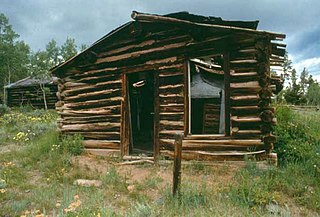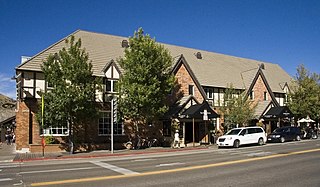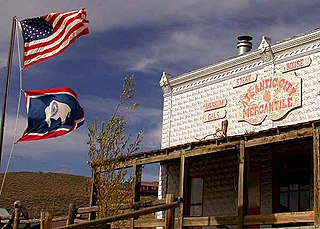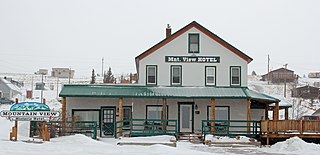
South Pass City is an unincorporated community in Fremont County, Wyoming, United States. It is located 2 miles (3 km) south of the intersection of highways 28 and 131. A former station on the Oregon Trail, it became a ghost town after later gold mines were closed. The entire community is listed on the National Register of Historic Places. The closest town is Atlantic City. Some people have returned.

Hamilton City, or Miner's Delight as it was commonly known, was a town in Fremont County, Wyoming, United States, on the southeastern tip of the Wind River Range, that prospered during the mining boom in the American West in the second half of the 19th century. It was a "sister city" of Atlantic City and South Pass City. Today a few buildings still stand as a reminder of an era in Wyoming's past history.

The Sheridan Inn is a historic hotel in Sheridan, Wyoming. Designed by the architect Thomas R. Kimball of Omaha, Nebraska in 1893, it was constructed by the Chicago, Burlington, and Quincy Railroad as part of its development program in Wyoming associated with extension of the railway. Equipped with the first bathtubs and electric lights in that part of Wyoming, the inn was considered the "finest hotel" between Chicago and San Francisco. It was declared a National Historic Landmark in 1964.

The Lake Hotel, also known as Lake Yellowstone Hotel is one of a series of hotels built to accommodate visitors to Yellowstone National Park in the late 19th and early 20th century. Built in 1891, it is the oldest operating hotel in the park. It was re-designed and substantially expanded by Robert Reamer, architect of the Old Faithful Inn in 1903. In contrast to the Old Faithful Inn and many other western park facilities, the Lake Hotel is a relatively plain clapboarded Colonial Revival structure with three large Ionic porticoes facing Yellowstone Lake. It was designated a National Historic Landmark in 2015.

The Mammoth Hot Springs Historic District is a 158-acre (64 ha) historic district in Yellowstone National Park comprising the administrative center for the park. It is composed of two major parts: Fort Yellowstone, the military administrative center between 1886 and 1918, and now a National Historic Landmark, and a concessions district which provides food, shopping, services, and lodging for park visitors and employees. It was added to the National Register of Historic Places on March 20, 2002, for its significance in architecture, conservation, entertainment/recreation, and military. The district includes 189 contributing buildings.

The Wort Hotel was built in downtown Jackson, Wyoming, United States by brothers John and Jess Wort, who were significant figures in the transformation of the economy of Jackson Hole from ranching to tourism. The somewhat Tudor-style building was the first luxury hotel in Jackson. The two-story building features brick facing, with half-timbering and stucco on the second floor and a series of gables facing the street.

The Jenny Lake Boat Concession Facilities, also known as Reimer's Cabin and the Wort Boathouse, are a group of buildings on Jenny Lake in Grand Teton National Park. They include a dock, a boathouse, two employee cabins and Reimer's Cabin. The boathouse was built by concessioner Charles Wort, who held the original U.S. Forest Service use permit from the time before the establishment of Grand Teton National Park, when the lands and lake were under the jurisdiction of the Forest Service. Robert Reimer took over the concession by 1935 and built a personal residence in 1937. The log cabin is an example of the National Park Service Rustic style.

The Sheridan Flouring Mills, also known as the Mill Inn, are an industrial complex in Sheridan, Wyoming. The mills were a major component of the economy of north central Wyoming, providing collection, storage and milling of locally produced wheat and other grains into flour and other milled products. The original mill was established by Captain Scott W. Snively in the early 1890s. The Sheridan Milling and Manufacturing Company was sold to J.W. Denio in 1903, who operated the mill at its location on Broadway Avenue near downtown Sheridan. A catastrophic fire destroyed this mill in 1919, resulting in the purchase of a new location on Coffeen Avenue and construction of a much larger mill.

The Downtown Cody Historic District is the historic core of Cody, Wyoming, USA. "Historic" here refers to the early twentieth century, as Cody was not incorporated until 1901. Most of the commercial district was built between 1901 and the 1930s. The district extends along Sheridan Avenue for two blocks, with buildings of brick and local sandstone with storefront display windows. The chief building in the district is the Irma Hotel, individually listed on the National Register of Historic Places.
The Sommers Ranch Headquarters Historic District is a historic ranch complex located southwest of Pinedale, Wyoming. The district includes 11 wooden buildings, including a homestead house, a bunkhouse, a barn, and various other farm buildings and outbuildings. Albert P. "Prof" Sommers founded the ranch in 1908. Sommers married May McAlister in 1911; after the couple bought land from May's parents and her friend Nellie Yates, their ranch grew to 1,900 acres (770 ha). The ranch is still operational and serves as an example of the many ranches built in the upper Green River Valley.

The Downtown Rock Springs Historic District is a 15.97-acre (6.46 ha) historic district that was listed on the National Register of Historic Places in 1994. It is roughly bounded by K, 4th, C, 2nd, A, and 5th Streets in downtown Rock Springs, Wyoming.

The Madison Hotel Boardwalk Atlantic City is located in Atlantic City, New Jersey, United States. It was built in 1929 and added to the National Register of Historic Places on December 20, 1984.

William Ellsworth Fisher was an architect who founded the Denver, Colorado firm that became Fisher & Fisher.

Atlantic City Mercantile is a former store now used as a bar and restaurant in Atlantic City, Wyoming. It is one of the chief buildings in the small mining town in the South Pass area of Wyoming, and is a significant example of a late 19th-century commercial building on what had recently been the frontier.
The Jelm-Frank Smith Ranch Historic District, also known as Old Jelm and Cummins City, comprises an area of bottomland on the Laramie River near Woods Landing, Wyoming where the mining boomtown of Cummins City, Wyoming was established in 1880. Gold had been discovered in the nearby mountains and the town was established by W.S. "Buck" Bramel and John Cummins. In 1881 Cummins City was described as having about 100 houses and a hotel. By this time the camp was already declining, and by 1886 mining in the district was largely inactive. However, in the 1890s copper was discovered in the Sierra Madre and Medicine Bow ranges. Cummins City was revived as Jelm in 1900. This boom also declined and in 1930 Jelm's population was 50.

The Parco Historic District, also known as the Sinclair Historic District, comprises the center of Sinclair, Wyoming, originally known as Parco, surrounding the Parco Inn. The district includes 93 buildings, of which 49 are considered to be contributing structures to the district. Sinclair was built as a company town in 1924-25 with a consistent design theme by architects Fisher & Fisher in the Spanish Colonial revival style. In addition to the Parco Inn other significant structures include the Sinclair Theatre and Recreation Hall, the school, the library and the Community Church. The central plaza, business district and original worker housing also contribute.
The Brooks Lake Lodge, also known as the Brooks Lake Hotel and Diamond G Ranch, as well as the Two-Gwo-Tee Inn, is a recreational retreat in Fremont County, Wyoming near Dubois in the upper Wind River valley. The complex was built in 1922 to accommodate travelers coming to Yellowstone National Park on U.S. Route 287 from central Wyoming. The buildings are mainly of log construction with Craftsman style detailing.

The Lander Downtown Historic District comprises the commercial core of Lander, Wyoming. The district includes 16 buildings listed as contributing to the historic district, including a series of commercial buildings, the Noble Hotel, the grand Theatre and the Stockgrower's Bar. The Federal Building is included, and is individually listed on the National Register of Historic Places as well. Most date between 1890 and 1910. Most earlier buildings burned or were torn down and replaced by more permanent masonry structures. By 1910 an oil boom had begun in central Wyoming, providing an incentive to build substantial buildings. The district comprises most of the north side of Main Street between Second Street and Fourth Street, with three properties on the south side and one facing Lincoln Street at Third Street.

The Mountain View Hotel is a historic hotel near Centennial, Wyoming. It was built in 1907 as the railroad arrived in Centennial in the declining years of a gold mining boom. The hotel was part of a community development plan to develop businesses that did not depend on mining. featured 20 rooms and three baths, but the bathrooms were originally located in a separate stable building. The hotel was bought by Gustav and Anna Sundby in 1914, who operated the hotel into the 1940s. In the 1950s the hotel became an apartment house.


















